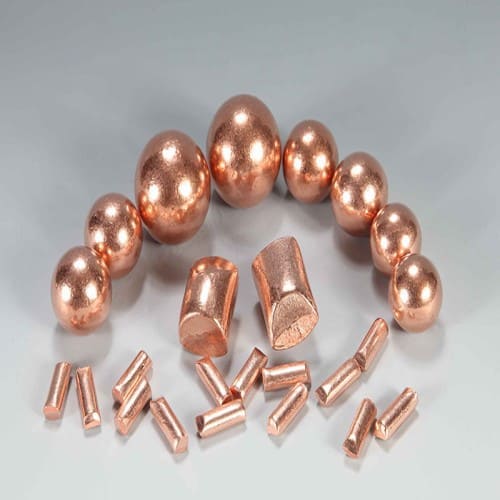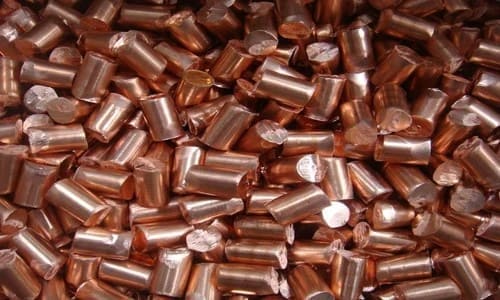• Anode Material:
Copper-plating anodes are typically made of high-purity copper metal. The purity of the anode material is essential to ensure consistent and reliable plating results.
• Electrochemical Reaction:
During copper electroplating, a direct current is applied to the plating bath. The anode releases copper ions into the solution through a process known as oxidation. These copper ions migrate towards the cathode (the substrate being plated) and are reduced onto its surface, forming a uniform layer of copper.
• Types of Copper Anodes:
There are two primary types of copper plating anodes: soluble and insoluble. Soluble anodes, often referred to as conforming anodes, are made of copper that dissolves as the plating process proceeds. Insoluble anodes, also known as inert anodes, do not dissolve during plating and are typically made of materials like platinum, graphite, or mixed-metal oxide (MMO) coatings.
• Anode Efficiency:
Anode efficiency refers to the ability of an anode to release metal ions into the plating solution. Copper anodes are known for their high anode efficiency, which means that a significant portion of the copper metal in the anode contributes to the plating process. This efficiency is crucial for maintaining a consistent plating rate and thickness.
• Maintenance and Replacement:
Soluble copper anodes gradually dissolve as the plating process continues. This can lead to a decrease in the concentration of copper ions in the bath over time. Anode maintenance and replacement are necessary to ensure stable plating conditions and maintain the desired copper concentration in the plating solution.
• Anode Design:
Copper-plating anodes come in various shapes and forms, including bars, rods, sheets, and baskets. The choice of anode design depends on factors such as the specific plating setup, bath geometry, and the shape of the substrate being plated.

Factors to consider when choosing the right copper plating anode
• The type of metal being plated:
The kind of copper plating anode required will depend on the kind of metal being plated. For instance, a pure copper copper plating anode is required if you are plating steel. A copper-zinc alloyed copper plating anode is required if you are plating zinc.
• The desired thickness of the plating:
The copper plating anode of choice will also depend on the desired plating thickness. You will require a bigger anode if your plating is thicker.
• The lifespan:
The type of copper, the operating circumstances, and the maintenance practices will all affect how long a copper plating anode lasts. Anodes for copper plating can typically endure for many years with adequate maintenance.
• The safety features:
Anodes for copper plating might be harmful if not handled correctly. Choosing an anode with the required safety features, such as a corrosion-resistant coating and a non-sparking design, is crucial.
Maintenance of copper plating anodes
• Regular Inspection:
Regularly inspect the condition of the anodes to identify any signs of corrosion, degradation, or uneven wear. This can help prevent issues before they become significant.
• Cleaning:
Clean the anodes periodically to remove any accumulated contaminants, oxidation, or debris. Use a soft cloth or non-abrasive material to gently clean the anode surfaces.
• Anode Rotation:
Rotate the position of the anodes within the plating bath. This helps ensure even wear and distribution of the anode material, preventing localized depletion and maintaining uniform plating.
• Anode Adjustment:
Depending on the specific electroplating setup, adjust the anode-to-cathode distance and positioning to optimize current distribution and uniform plating results.
• Electrolyte Analysis:
Regularly analyze the composition of the plating solution, including copper ion concentration, pH levels, and other additives. Make adjustments as needed to maintain the desired bath chemistry.
• Cathode Maintenance:
Keep the cathode (substrate being plated) clean and free from debris or contaminants. A clean cathode surface ensures efficient copper ion deposition.
• Control Current Density:
Maintain the appropriate current density for the plating process. High current densities can lead to uneven plating and excessive anode wear, while low current densities may result in poor adhesion.
copper plating anodes are essential components in the electroplating process, enabling the deposition of copper onto various substrates. Their material purity, efficiency, and proper maintenance play crucial roles in achieving consistent and high-quality plating results. As industries continue to evolve, so too will the technology and practices associated with copper plating anodes to meet environmental and efficiency goals. Supercon india is having its branches in Maharashtra, Karnataka, Tamil nadu and Gujarat.

